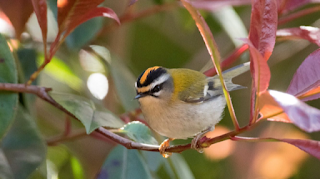January Update: A Winter's Tale
January is never the greatest month for inland birding in the
UK, and this year’s weather didn’t help with our New Forest patch sightings. Heavy rain
early in the month, followed by freezing temperatures, limited the opportunities
to get out and about, with only 5 full circuits being completed
since the New Year. Our peak monthly species count of 43 on 15th
January was well short of last year’s January record of 46, and dipped to 35 on
the 21st. Overall, 53 species have been recorded so far in 2023 (full
details on the link below – as before please note that Dartford Warbler sightings
are suppressed by the eBird site so do not show in these data)
https://ebird.org/hotspot/L12697095
The heathland areas of the patch were particularly quiet,
with very small numbers of Meadow Pipits and Skylark; it took
until the 29th of the month to see our first Stonechat of the
year, which is unusual even for January. Hopefully this just reflects movement
to different locations rather than a more sinister effect on their population,
but we will watch this with interest over the coming weeks. Regular sightings
of Dartford Warblers, although also low in number, suggest that they have
so far escaped the effects of the two extreme cold snaps we have already
experienced this winter. A small group of up to 7 Lapwing were found roosting
on an area of the heath close to Longslade View, which is a regular site for this
species at this time of year. Snipe were seen just once during our patch walks, but this may be a reflection of their
being more widely distributed across the very wet heath.
Firecrest (photo credit: Matt Roseveare)
In the woodland, Green Woodpeckers have been in good
voice most weeks, although it took until the 21st before we heard
our first drumming Great Spotted Woodpecker. Tree Creepers and Nuthatches
were seen and heard intermittently, but we are yet to find our first Marsh
Tit of the year. A Firecrest gave us great views in Hincheslea Woods
on New Year’s Day, and Goldcrest have been quite widespread in the gorse
and scrub, which is a pattern we have observed in previous winters.
Song and Mistle Thrushes have started to sing again and
there are good numbers of Redwing at several locations across the patch,
despite the exhaustion of most of the supply of berries. Fieldfare are
also present, though fewer in number than in the Autumn, with a flock of around
18 birds on Setley Plain, which is a similar site to last year.
The water level at Setley Pond has been very high, following the heavy rain early in the month, and the subseqent drop in temperature caused it to freeze over for several days. Cormorants have been frequent visitors to the pond, along with up to 5 Mallard and our regular Grey Heron. We were also pleased to find our first Kingfisher at this location on our New Year’s Day walk. A patch birding ‘highlight of the month’ was a visit from a pair of Goosander, which touched down briefly on 15th January, before realising their mistake at the sight of the radio-controlled boats, and making a rapid exit to the South.
Swollen and Frozen: Setley Pond in mid-January
All the regular Corvid species have been present in good numbers,
with large flocks of Jackdaws and Rooks roosting in Sway village during the winter;
Ravens, which tend to disappear from the patch in the Summer months, have
started to become more active again and have been regular visitors during this
month. Black Headed Gulls have started to reappear, after a few months’
absence to join our perennial population of Herring Gulls.
As the weather improves over the coming weeks we look forward
to increased numbers of heathland birds, and perhaps some movement of waterfowl.
Early mornings in February usually brings the sound of Canada Geese and perhaps
we can manage to get out early enough to add Tawny Owl to the list!







Comments
Post a Comment